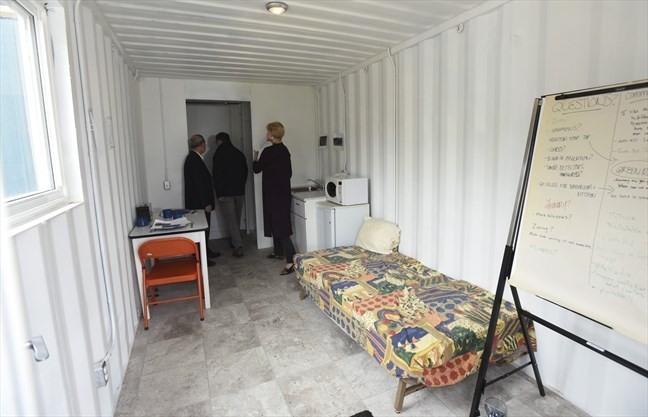Container home plan could be piloted before winter, creating affordable units for homeless
Before the snow flies next winter, some of the most vulnerable members of the community may end up finding shelter inside a collection of shipping containers.
Tiny Town: that’s what creators are calling the proposed project aimed at providing housing for those living on the street and sleeping rough in parks and forests.
“It’s a bold solution to a critical problem,” said Ward 4 councillor Mike Salisbury at an open house – or open box – event on Thursday morning. He and several other city councillors, along with Guelph mayor Cam Guthrie, MPP Mike Schreiner and MP Lloyd Longfield came by the site to see the proposal.
The manufacturing prototype was on display at the Wike Bicycle Company at the corner of Stevenson and Beverley streets. Inside was 150 square feet of living space, complete with a toilet and shower, kitchen area and a single bed.
Ward 1 councillor Bob Bell is the owner of Wike and has been working with Adrienne Crowder, manager of the Wellington Guelph Drug Strategy, since last year to develop this tiny home project. He said the idea was born out of a desperate need for affordable housing in the community.
Earlier this year, the mayor’s homelessness task force brought forward a recommendation to create 15 permanent supportive housing units to house the most vulnerable members of the community. Such a project, built from the ground up, could cost upwards of $4.5 million with annual costs of nearly a million dollars.
Bell said in contrast to that proposal, by transforming 10 eight-by-20 steel containers into livable spaces, the cost of each unit would be around $50,000, with negligible operating costs.
According to the plan at the event, 10 boxes would be arranged in a herringbone pattern with water all plumbing services at one end to keep things efficient. An additional unit could be added for laundry machines, office space or a spot for other community supports.

The plan: the photo on the left shows the position of the 11 containers. The photo on the right shows the proposed foundation with city services running underneath the homes. The collection of containers could fit in a lot that is 15 by 24 metres (50 by 80 feet).
Crowder said the container home plan could be a good way to get homeless people into housing. She said because the capital costs would be so low, it would be affordable and sustainable for someone receiving monthly supports from Ontario Works (OW).
For people who use substances, finding somewhere to live on an OW housing allowance of $390 a month is very difficult, she said. Outside of affordability, landlords don’t typically want to rent to someone who uses substances.
By providing housing for those struggling with addiction and homelessness, it could allow them to turn themselves around, Crowder said. They’ll have the chance to improve their health, they’ll have less police interactions – there will be a ripple effect.
“They’ll be able to manage their lives. They won’t be forced into constantly putting all their energy into where they’re going to be tonight.”
One of the requirements to live in such a community might be to be on the by-name list and accessing local services.
She said Thursday’s event was to gauge reaction from the community at large. Visitors were encouraged to share their thoughts on a piece of paper inside the space.
Chris (the Mercury Tribune has agreed not to publish his last name) is currently homeless. He and his partner have been couch-surfing and moving from place to place for some time now. He attended the event on Thursday and said he was impressed with the space.
He said if this prototype was available, “I’d move in today.” The space is big enough for one person, but if families were living there, it might be a little tight, he said, suggesting a longer container be made available for families.
Chris said he’s recovering from a substance addiction and can’t stay in the city’s shelter system because many of the people there act as a trigger for him. He said because he’s been homeless for a while and was previously addicted to substances, it’s been hard to find a landlord who will rent to him, or an employer who will hire him.
He said he’s hopeful this project will pan out, adding the city is in desperate need of housing units that people can afford.
Guelph mayor Cam Guthrie said the goal should be to have this plan in place before the winter returns, but before it gets the green light there are a few hurdles to get over first, including zoning, infrastructure, placement and access to support services.
The next step will be to for council to ask staff to look into those hurdles and how to get over them, he said. If nothing is done, the community will continue to find people “sleeping rough” in parks or off wooded trails in the city.
Building homes out of shipping containers isn’t a new idea in Guelph, but there hasn’t been a proposal like this to specifically target homelessness. Guthrie said over the recent years the rules and bureaucracy around building codes have become more accepting of tiny home solutions and the stigma attached to living in such a space has been eroded.
“We have a convergence here of opportunity.”
Bell said the project is not just looking at addressing homelessness in Guelph, but it’s setting up a pilot that can be copied in communities throughout the country.
“We’re not trying to solve our problem here. We’re trying to create a process where it can be replicated everywhere, very fast.”

